|
| | Vienne - La Hofburg de Marie-Antoinette |  |
| | | Auteur | Message |
|---|
madame antoine

Nombre de messages : 6902
Date d'inscription : 30/03/2014
 |  Sujet: Vienne - La Hofburg de Marie-Antoinette Sujet: Vienne - La Hofburg de Marie-Antoinette  Mer 10 Déc - 9:09 Mer 10 Déc - 9:09 | |
| Bonjour, mes Chers Amis, Le Boudoir de Marie-Antoinette contient déjà beaucoup de renseignements sur la Hofburg, mais ceux-ci sont dispersés car ce palais ne dispose pas encore d'un sujet qui lui soit entièrement dévolu. C'est pourquoi, en raison aussi du fait que la Hofburg est le lieu de naissance de l'Archiduchesse Marie-Antoinette, j'ai pensé qu'il serait bien d'ouvrir un sujet spécifique. Tout d'abord, il faut savoir que la Hofburg telle que nous la voyons lorsque nous visitons Vienne n'est pas celle du temps de Marie-Antoinette car des éléments ont été ajoutés par la suite.Voici une vue ancienne de Vienne.  madame antoine
_________________
Plus rien ne peut plus me faire de mal à présent (Marie-Antoinette)
|
|   | | pimprenelle

Nombre de messages : 40589
Date d'inscription : 23/05/2007
 |  Sujet: Re: Vienne - La Hofburg de Marie-Antoinette Sujet: Re: Vienne - La Hofburg de Marie-Antoinette  Mer 10 Déc - 9:40 Mer 10 Déc - 9:40 | |
| Super sujet!  Je me souviens en effet que beaucoup de pièces de la Hofburg étaient meublées comme du temps de Sissi.  L'aile autrefois occupée par Marie Thérèse n'était même pas visitable, lorsque je suis allée à Vienne... 
_________________
rien que la mort peut me faire cesser de vous aimer
|
|   | | Chou d'amour
Administrateur
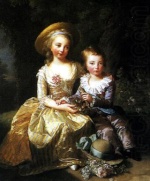
Nombre de messages : 31526
Age : 42
Localisation : Lyon
Date d'inscription : 22/05/2007
 |  Sujet: Re: Vienne - La Hofburg de Marie-Antoinette Sujet: Re: Vienne - La Hofburg de Marie-Antoinette  Mer 10 Déc - 9:42 Mer 10 Déc - 9:42 | |
| Magnifique en effet, merci madame antoine 
_________________
Le capitalisme c'est l'exploitation de l'homme par l'homme. Le syndicalisme c'est le contraire!
|
|   | | pimprenelle

Nombre de messages : 40589
Date d'inscription : 23/05/2007
 |  Sujet: Re: Vienne - La Hofburg de Marie-Antoinette Sujet: Re: Vienne - La Hofburg de Marie-Antoinette  Mer 10 Déc - 9:51 Mer 10 Déc - 9:51 | |
| Je vais aussi essayer de trouver des tableaux d'époque sur le net! 
_________________
rien que la mort peut me faire cesser de vous aimer
|
|   | | madame antoine

Nombre de messages : 6902
Date d'inscription : 30/03/2014
 |  Sujet: Re: Vienne - La Hofburg de Marie-Antoinette Sujet: Re: Vienne - La Hofburg de Marie-Antoinette  Mer 10 Déc - 10:56 Mer 10 Déc - 10:56 | |
| Mes chers Amis, je me réfère à la biographie de Marie-Thérèse d'Autriche par Jean-Paul Bled, Perrin, Tempus, édition 1212, page 17. Dans son enfance, l'Archiduchesse Marie-Thérèse séjournait à la Hofburg ou bien à la Nouvelle Favorite. Son père Charles VI effectua des aménagements à la Hofburg, qui ayant été agrandie au cours des siècles précédents ne constituait pas un ensemble d'un seul tenant. Charles VI poursuivait un double but, le premier était d'unir cet édifice hétéroclite. Le second était de l'embellir pour lui donner un visage convenant à ce qu'il était lui-même, Charles VI du Saint-Empire, le premier Prince de la Chrétienté. Voici un portrait de Charles VI attribué à Meytens  Charles VI fit appel aux plus grands architectes de son temps. En face de L'Aile Léopoldine, Johann Lukas von Hildebrandt construit la Chancellerie d'Empire (Reichskanzlei), symbole de la place tenue par la Saint Empire dans le système autrichien. Ce bâtiment vient fermer la Cour Intérieure, ce qui lui donne l'aspect que nous connaissons de nos jours. Un autre édifice est commandé aux architectes Fischer von Erlach Père et Fils. Il s'agit d'une Bibliothèque de Cour (Hofbibliothek) symbolisant le mécénat culturel de Charles VI. Au centre de la Salle d'Appart trône une statue d'Hercule des Muses sous les traits de l'Empereur.  Enfin, Charles VI fait construire une Ecole Equestre d'Hiver (Winterreitschule). On y organise des fêtes somptueuses. A l'issue de ces grands travaux, si l'aspect hétéroclite de la Hofburg n'a pas disparu, on y trouve une majesté qui compense les différences de styles. Bien à vous madame antoine
_________________
Plus rien ne peut plus me faire de mal à présent (Marie-Antoinette)
|
|   | | pimprenelle

Nombre de messages : 40589
Date d'inscription : 23/05/2007
 |  Sujet: Re: Vienne - La Hofburg de Marie-Antoinette Sujet: Re: Vienne - La Hofburg de Marie-Antoinette  Mer 10 Déc - 20:16 Mer 10 Déc - 20:16 | |
| Merci pour ces renseignements!  Voici quelques petites infos glanées sur le net: Ce palais impérial de la Hofburg constitue avec ses 18 ailes, ses 54 escaliers, ses 19 cours intérieures et ses quelque 2600 pièces, le véritable centre du pouvoir séculaire des souverains autrichiens. De 1439 à 1806 il servit de résidence aux Rois et aux Empereurs d’Autriche. Selon la tradition aucun souverain ne vécut dans les pièces habitées par son prédécesseur.

C'est vraiment grandiose, immense. Il y a:
- le palais impérial
- le nouveau palais impérial
- le vieux château
- la chancellerie impériale
- le petit château d'Amalia
- l'école d'équitation
- la looshaus
- les écuries impériales
- la bibliothèque nationale
- le jardin impérial
- la maison des papillons
D'où l'expression: "une ville dans la ville" qui qualifie la Hofburg (ouvert tous les jours de 9h à 17h)http://jysuisallee.canalblog.com/archives/2007/03/21/7934154.html
_________________
rien que la mort peut me faire cesser de vous aimer
|
|   | | Maria Cosway
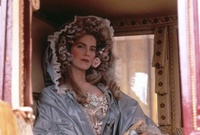
Nombre de messages : 733
Date d'inscription : 05/07/2015
 |  Sujet: Re: Vienne - La Hofburg de Marie-Antoinette Sujet: Re: Vienne - La Hofburg de Marie-Antoinette  Sam 7 Nov - 0:13 Sam 7 Nov - 0:13 | |
| How Maria Antonia was born at the Hofburg : Born as the last of the children of Empress Maria Theresia and the Holy Roman Emperor, Francis Stephen, the future Queen of France Marie Antoinette, was also the imperial couple’s fifteenth child and eleventh daughter. She was born on November 2 1755, the Feast of the Dead in Catholic Austria’s calendar and baptised under the names Maria Antonia Josepha Johanna, but known within the family simply as Antoine, celebrating her name day on the Feast of St. Anthony. However, as Marie Antoinette’s biographer Antonia Fraser has pointed out, Marie Antoinette’s birthday was generally celebrated on the evening before, on a less ominous day in the Catholic calendar – November 1, All Saint’s Day, leaving St. Anthony’s Day as her own personal feast day. Maria had been the established prefix used for female members of the imperial house since the reign of Leopold I, a practice that was continued by Maria Theresia, whose surviving sister had also been christened Maria Anna in her turn. This tradition was preserved by Maria Theresia, whose daughters all bore this first name in honour to the Virgin Mary, to whom the house of Habsburg was devotedly attached – prior to her marriage by proxy to the French Dauphin, the future Marie Antoinette would make devotions in 1769 at Maria Zell, arguably Austria’s most important national place of pilgrimage, with the venerated image of the Virgin, the “Great Mother of Austria”, the Magna Mater Austriae. Maria had been the established prefix used for female members of the imperial house since the reign of Leopold I, a practice that was continued by Maria Theresia, whose surviving sister had also been christened Maria Anna in her turn. This tradition was preserved by Maria Theresia, whose daughters all bore this first name in honour to the Virgin Mary, to whom the house of Habsburg was devotedly attached – prior to her marriage by proxy to the French Dauphin, the future Marie Antoinette would make devotions in 1769 at Maria Zell, arguably Austria’s most important national place of pilgrimage, with the venerated image of the Virgin, the “Great Mother of Austria”, the Magna Mater Austriae.
Marie Antoinette was born after a labour which lasted all day, at about 8.30 in the evening, after which her father, Emperor Francis Stephen, announced the birth to those of the court who were waiting in the next room. Accounts record that she was a small child.The future Marie Antoinette was born at the Hofburg, the imperial palace in the centre of Vienna that had been the acknowledged seat of government from the 13th century onwards, being the chief residence of the rulers of the Holy Roman Empire until Emperor Franz I/II who then became the first Emperor of Austria, the Hofburg palace then remaining the main residence of Austria’s Emperors until the downfall of the monarchy in 1918. The old baroque wing of the so-called Leopoldnischer Trakt or Leopoldine Wing, housed the apartments of Maria Theresia, who used them when not at Schönbrunn or Laxenburg, the latter imperial holiday residence which Marie Antoinette would particularly come to love.
Unlike the apartments at Schönbrunn however, Maria Theresia’s former rooms in the Leopoldine Wing are not accessible to the public, because they contain the federal chancellery offices of the Austrian President. The Leopoldine Wing still acts as the connecting tract between the Amalienburg – named after the Empress Amalie Wilhelmine, widow of Emperor Leopold I – and the Swiss Court, or Schweizerhof, the Swiss Wing housing the oldest parts of the Hofburg dating back to the 13th century and also containing the Hofburg Chapel, or Burgkapelle. The Leopoldine Wing dates back to the reign of Emperor Leopold I, after whom the Wing was named and by whom it was built in around 1660. It was originally designed by the architect Filiberto Lucchese but later rebuilt by Giovanni Pietro Tencala following the Siege of Vienna by the Turks. Hofburg - ViennaFollowing a fire, Maria Theresia had redecorated the wing very much to her taste, similar to her renovation of the imperial summer palace at Schönbrunn, together with the architect Nicolo Pacassi, creating the image of Schönbrunn with the “Maria Theresia-Yellow” that we know today. Hofburg - ViennaFollowing a fire, Maria Theresia had redecorated the wing very much to her taste, similar to her renovation of the imperial summer palace at Schönbrunn, together with the architect Nicolo Pacassi, creating the image of Schönbrunn with the “Maria Theresia-Yellow” that we know today.
Marie Antoinette was born in the room that corresponds today to the presidential salon, then known as the Imperial Room but now called the Maria Theresia Room, fittingly because this was the bedroom of the Empress and a large oil painting of her still hangs here. A beautiful room in red, white and gold, it also contains a painting of the same room from the year 1919, an 17th century German astronomical clock and a pendant portrait of Marie Antoinette’s father, Emperor Francis Stephen.
Underneath this portrait is Maria Theresia’s escritoire, or writing desk, inlaid with tortoiseshell and mother-of-pearl. This is an appropriate piece of furniture, because even directly after the birth of Marie Antoinette, Maria Theresia resumed her paperwork and the business of governing the country, although she had still not officially left her bed. The newborn Archduchess was baptised the following day, November 3, in the so-called “Anticamera”, a ceremony performed by the Archbishop of Vienna.
It is poignant to note that today within the Hofburg, some traces of Marie Antoinette remain, a fitting tribute within the sprawling imperial complex in which she was born. Within the Imperial Apartments in the so-called Boucher Room, may be found a series of tapestries from the Parisian manufactory Gobelin, which were gifts from Marie Antoinette’s spouse, King Louis XVI of France to Marie Antoinette’s brother the Emperor Joseph II, who visited France in 1777 and advised the young couple in matters relating to their childlessness. A happy result of the Emperor Joseph’s visit was that Marie Antoinette shortly after became pregnant and the delighted couple sent these tapestries among other gifts as a token of their gratitude.
In the Large Anteroom of the Hofburg can be found several charming paintings of Maria Theresia’s sixteen children, engaged in dancing and singing; among which is the famous painting by Martin Mytens of Marie Antoinette with her brothers, the Archdukes Ferdinand and Max, performing the ballet Il Triofo d’Amore by Metastasio. Marie Antoinette loved this picture and a version of it later found its way – to her delight – to Versailles. It hangs today in the Petit Trianon, her beloved retreat. A watercolour of Marie Antoinette with her beloved sister Maria Carolina by Antonio Pencini from 1764, is also held at the Hofburg. It is also charming to note that in the Silberkammer at the Hofburg within the Kaiserapartments, can be found two Sevres services, one with green ribbons which was a present from King Louis XV of France to Maria Theresia and another which was a gift from Louis XVI and Marie Antoinette to Emperor Joseph II on the occasion of his 1777 visit to France.http://royalcentral.co.uk/blogs/history/a-november-archduchess-the-birth-of-marie-antoinette-54994
_________________
Who knows what lies beneath ?
|
|   | | Maria Cosway

Nombre de messages : 733
Date d'inscription : 05/07/2015
 |  Sujet: Re: Vienne - La Hofburg de Marie-Antoinette Sujet: Re: Vienne - La Hofburg de Marie-Antoinette  Sam 22 Avr - 3:46 Sam 22 Avr - 3:46 | |
| Hello my dear friends !  Reading Elena Maria Vidal's Tea At Trianon I found another interesting article about the Hofburg Building.  http://teaattrianon.blogspot.be/2017/04/where-marie-antoinette-was-born.html Here it is, with some beautiful pictures.  Taking a look at where Marie Antoinette was bornAs the seat of power from which the Habsburg emperors ruled over their vast empire – the furthest of which points extended from the modern Czech Republic to Croatia, from Italy to the borders of today’s Russian Federation – the Hofburg Palace has come to symbolise Austrian – and of course, Viennese – history itself. Walking around its vast complex, of which only certain areas are open to the public, is to feel that you are passing between random chapters of this history, beginning with the first mentions of the Hofburg in the 13th century with the so-called Swiss Wing, through to the construction of the Neue Burg (New Castle) in the early 20th-century, where today’s Hofburg Congress Centre is also located. Quite literally, the Hofburg is a book which is (partially) open to you, to browse. Taking a look at where Marie Antoinette was bornAs the seat of power from which the Habsburg emperors ruled over their vast empire – the furthest of which points extended from the modern Czech Republic to Croatia, from Italy to the borders of today’s Russian Federation – the Hofburg Palace has come to symbolise Austrian – and of course, Viennese – history itself. Walking around its vast complex, of which only certain areas are open to the public, is to feel that you are passing between random chapters of this history, beginning with the first mentions of the Hofburg in the 13th century with the so-called Swiss Wing, through to the construction of the Neue Burg (New Castle) in the early 20th-century, where today’s Hofburg Congress Centre is also located. Quite literally, the Hofburg is a book which is (partially) open to you, to browse.
 The complex invariably bears the marks of the individual Habsburg rulers themselves, who added their extensions according to their own personal tastes and requirements; these areas becoming thus intrinsically linked with them, as well as historically significant because of the events that took place within them – during their own reigns and subsequently. The complex invariably bears the marks of the individual Habsburg rulers themselves, who added their extensions according to their own personal tastes and requirements; these areas becoming thus intrinsically linked with them, as well as historically significant because of the events that took place within them – during their own reigns and subsequently.
The Hofburg’s styles range from the unmistakably Gothic with the building of the Burgkapelle (Hofburg Chapel) to the baroque Josefsplatz, with its equestrian statue of Emperor Joseph II. Located on the Josefsplatz is the Court Library (within today’s Austrian National Library) with its magnificent Prunksaal containing some 200,000 books, including the 15,000 strong rare book collection of the great general and military commander Prince Eugene of Savoy – an acknowledged hero in Viennese terms, for his services to the Habsburg empire in the field, which broke the yoke of the Ottoman domination that had held much of Europe in its grip.
Next to the library is the Augustine Wing, which contains the Court Church of the Hofburg, the Augustinerkirche (Church of the St Augustin Friars) which formed the setting for important weddings within the Habsburg family, including that of the Emperor Franz Josef I to Princess Elisabeth in Bavaria and several by proxy, including that of the future Marie Antoinette to the Dauphin Louis-Auguste in 1770. Marie Antoinette’s mother, Empress Maria Theresa had herself married Francis Stephen, Duke of Lorraine here, too, in 1736. As part of the Neue Burg was the Kaiserforum – a project planned by the architect Gottfried Semper which was only partially realised, with the building of the Kunsthistorisches and the Naturhistorisches Museum in the 1890s and the south-west wing of the Burg overlooking the Burggarten, which was completed in 1913.
The Archduchess Maria Antonia – Maria being an established Habsburg prefix given to all the daughters of Empress Maria Theresia, to mark the dynasty’s special allegiance to and veneration for, The Virgin Mary – was born as the 15th child of Maria Theresia on 2 November 1755 at around 8.30 in the evening. She was one of 11 daughters to the imperial couple. She celebrated her name day – a day with probably even greater personal importance to her than her actual birthday – on the Feast Day of St Antony on 13 June. She was christened the day after her birth promptly, being baptised under the names Maria Antonia Josepha Johanna. Maria Theresia had abolished the practice of a public delivery, which was something however – as Marie Antoinette’s biographer Antonia Fraser has correctly pointed out – that the future Queen of France would encounter in her time, as being very much still de rigeur at Versailles.
Maria Theresia’s rooms at the Hofburg Palace were located in the so-called Leopoldnischer Trakt (Leopoldine Wing) which was built in the 1660s during the reign of Emperor Leopold I, after whom the wing takes its name. Today, these are part of the Austrian Chancellery of the Federal President and are therefore not open to the public. The Leopoldine Wing connects the much older Swiss Wing – with its famous Swiss Gate – to the Amalienburg and directly faces the Imperial Chancellery. Originally constructed under the Swiss-Italian architect Filberto Lucchese, it was later enlarged by Giovanni Pietro Tencala. The Leopoldine Wing as seen from the main Hofburg courtyardMaria Theresia used the rooms in the Leopoldine Wing primarily during the winter. Summers were being spent increasingly at the imperial residences of Schönbrunn and Laxenburg, the former of which she had enlarged considerably under the direction of the Austro-Italian court architect Nicolo Pacassi. (The old Favorita – today’s Theresianum – the aptly-named favourite residence of her father Emperor Charles VI, ceased to be used by the imperial family following the Emperor’s death.) Although the childhood of the future Marie Antoinette was spent in Vienna between the Hofburg Palace and the imperial summer palace at Schönbrunn, it was the lovely baroque residence at Laxenburg some 12 miles outside Vienna near Mödling, that she grew particularly to love – also known as the ‘Blauer Hof’ (Blue Court). Today the former castle houses the International Institute for Applied Systems Analysis (IIASA) and is not accessible to the public. The Leopoldine Wing as seen from the main Hofburg courtyardMaria Theresia used the rooms in the Leopoldine Wing primarily during the winter. Summers were being spent increasingly at the imperial residences of Schönbrunn and Laxenburg, the former of which she had enlarged considerably under the direction of the Austro-Italian court architect Nicolo Pacassi. (The old Favorita – today’s Theresianum – the aptly-named favourite residence of her father Emperor Charles VI, ceased to be used by the imperial family following the Emperor’s death.) Although the childhood of the future Marie Antoinette was spent in Vienna between the Hofburg Palace and the imperial summer palace at Schönbrunn, it was the lovely baroque residence at Laxenburg some 12 miles outside Vienna near Mödling, that she grew particularly to love – also known as the ‘Blauer Hof’ (Blue Court). Today the former castle houses the International Institute for Applied Systems Analysis (IIASA) and is not accessible to the public.
The Leopoldine Wing is entered by means of the Adlerstiege (Eagle’s Staircase) up to the first rooms of Maria Theresia’s suite, the Bellariazimmer. These contain portraits of the imperial family, including Emperor Leopold I, the Emperor of the eponymous Wing – and paintings of Emperor Leopold I’s first wife, Margarita Teresa of Spain and of the future Emperor Charles VI, Marie Antoinette’s maternal grandfather and son of Leopold I by his third wife, Eleonore Magdalene of Neuburg. The second Bellariazimmer bears the strong imprint of Maria Theresia’s family and personality – again there are portraits of the Empress herself, her co-regent and eventual successor Joseph II, her husband, Francis Stephen – Holy Roman Emperor Francis I. Stephen since 1745 – and a further portrait of her mother, Empress Elisabeth Christine – together with two pastels by the Swiss-French painter Jean-Etienne Liotard, whose work she enthusiastically patronised. The Rosenzimmer (Rose Room) is so named after the supraporten – the oval oil paintings above the doors – which contain images of flowers. The Pietra Dura Room leads into the magnificent Spiegelsaal, or Mirror Room – which was where the courtiers gathered to await the news of the outcome of Maria Theresia’s labour with her fifteenth child. It was into this room that Francis Stephen emerged after the birth to announce the news of the birth of his (11th) baby daughter.
This child – the future Marie Antoinette – was born in what is today called the ‘Maria Theresia Room’, which was originally the ‘Rich Room’ – the bedroom of Maria Theresia and Francis Stephen. It was decorated with dark red velvet and embroidered in gold. The bed would have stood at the centre wall, where today a sofa stands flanked by flags, above which hangs an enormous portrait of Maria Theresia by the Swedish-Dutch court artist Martin van Meytens. Remarkably, the imperial bed has been preserved and is kept at Schönbrunn Palace – behind glass. The red velvet bed was originally made for the bedroom of Maria Theresia’s parents, Emperor Charles VI and Empress Elisabeth Christine at the Favorita – but was moved to Maria Theresia’s rooms in the Leopoldine Wing when Maria Theresia and Francis Stephen moved into the Hofburg in 1740. As with most state beds, it performed rather more of a ceremonial function in the business of court ritual as opposed to being a bed for actual use – so, it is unlikely that the future Marie Antoinette was born upon this bed and that a separate delivery bed would have been employed instead, as was the case for example with Marie Antoinette’s first child Madame Royale in 1778. The bed remained at the Hofburg until 1947, when the former bedroom in the Leopoldine Wing was converted into the Presidential Suite.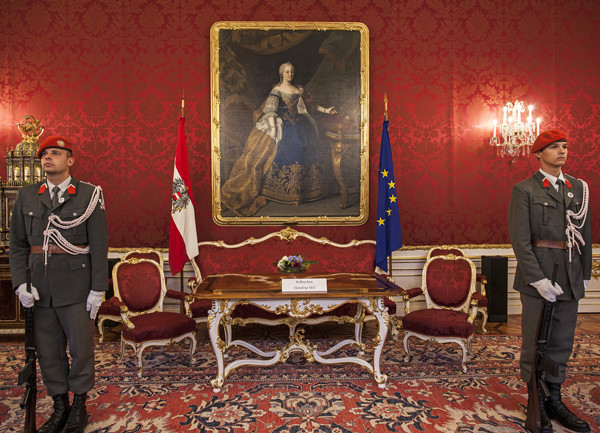 As one might expect for this important room within the suite of the Federal President, the decoration is fittingly appropriate in the Austrian national colours of red and white. Also kept in this room is Empress Maria Theresia’s writing desk. This object is appropriate to the future Marie Antoinette’s birth in more ways than one – Maria Theresia worked before she left her bed – but also, is a testament to the sentiments of the tireless Empress. As Maria Theresia famously said: “My subjects are my first children,” and as such, despite having just become a mother for the 15th time herself, she saw it as necessary to continue her duties as a mother – to Austria – in another way too. As one might expect for this important room within the suite of the Federal President, the decoration is fittingly appropriate in the Austrian national colours of red and white. Also kept in this room is Empress Maria Theresia’s writing desk. This object is appropriate to the future Marie Antoinette’s birth in more ways than one – Maria Theresia worked before she left her bed – but also, is a testament to the sentiments of the tireless Empress. As Maria Theresia famously said: “My subjects are my first children,” and as such, despite having just become a mother for the 15th time herself, she saw it as necessary to continue her duties as a mother – to Austria – in another way too.http://royalcentral.co.uk/blogs/taking-a-look-at-where-marie-antoinette-was-born-79812
_________________
Who knows what lies beneath ?
|
|   | | madame antoine

Nombre de messages : 6902
Date d'inscription : 30/03/2014
 |  Sujet: Re: Vienne - La Hofburg de Marie-Antoinette Sujet: Re: Vienne - La Hofburg de Marie-Antoinette  Ven 10 Avr - 10:51 Ven 10 Avr - 10:51 | |
| Au sein de la Hofburg, on peut admirer les appartements appelés Berglzimmer dont les parois furent peintes en 1766 par Johann Wenzel Bergl pour Marie-Thérèse. 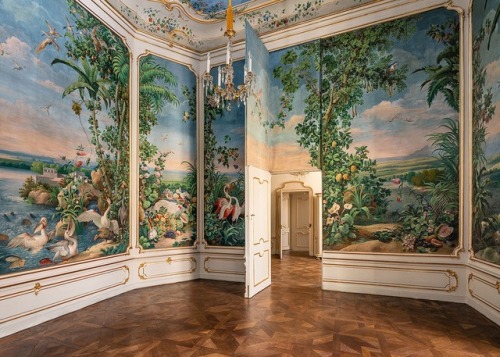 Bergl était l'un des artistes favoris de Marie-Thérèse et réalisa pour elle des décors de paysages exotiques.  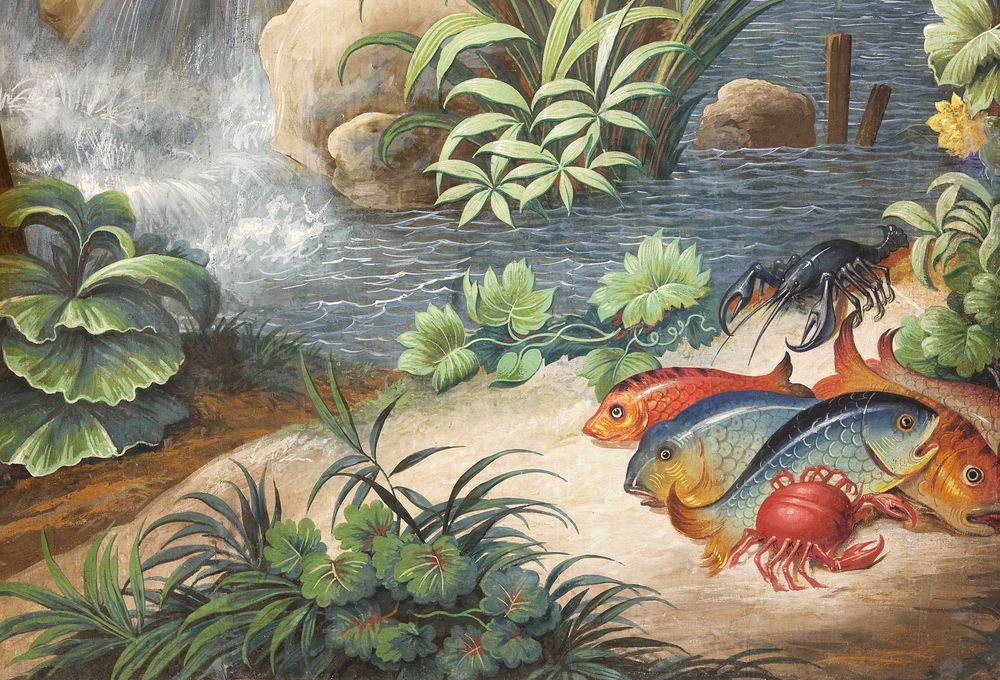  Bien à vous madame antoine
_________________
Plus rien ne peut plus me faire de mal à présent (Marie-Antoinette)
|
|   | | Contenu sponsorisé
 |  Sujet: Re: Vienne - La Hofburg de Marie-Antoinette Sujet: Re: Vienne - La Hofburg de Marie-Antoinette  | |
| |
|   | | | | Vienne - La Hofburg de Marie-Antoinette |  |
|
Sujets similaires |  |
|
| | Permission de ce forum: | Vous ne pouvez pas répondre aux sujets dans ce forum
| |
| |
| |
